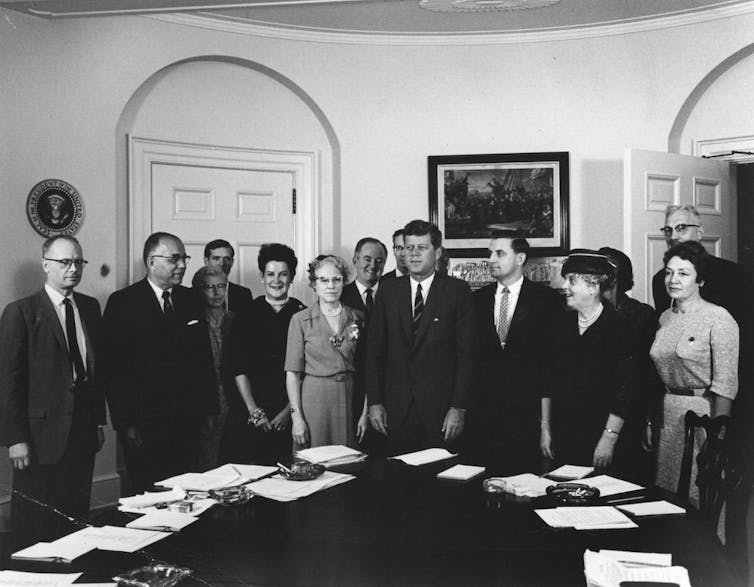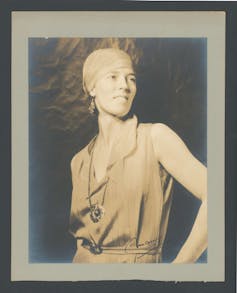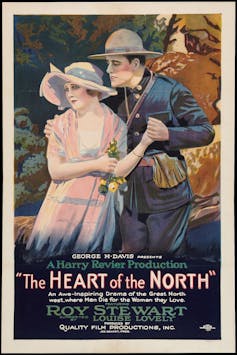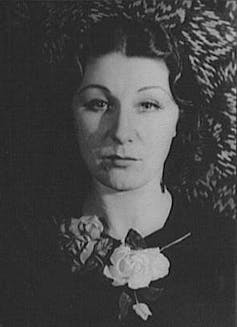The Australian women expats who found liberation in the US
- Written by Anne Rees, David Myers Research Fellow, La Trobe University
Obituary writers paid tribute last week to Jill Ker Conway, an Australian writer and historian who died on June 1 in Boston, aged 83, after spending most of her adult life in the US. Educated at Harvard, Ker Conway came to prominence in 1975 when she was appointed the first woman president of Massachusetts’ august Smith College.
In Australia, Ker Conway is best known for her acclaimed memoirs, The Road from Cooraine (1989) and True North (1994), which recount how she fled the narrow, sexist world of her youth to pursue a life of the mind in New England. By the time The Road from Coorain was adapted for television in 2002, Ker Conway was one of Australia’s most iconic expats; a US equivalent to London-based figures such as Germaine Greer and Clive James.
 A portrait of Jill Ker Conway, made in 1987 by Sarah Belchetz-Swenson, part of the First Ladies: Significant Australian Women 1913-2013 exhibition.
National Portrait Gallery
A portrait of Jill Ker Conway, made in 1987 by Sarah Belchetz-Swenson, part of the First Ladies: Significant Australian Women 1913-2013 exhibition.
National Portrait Gallery
Less well known is the fact that Ker Conway was far from unique. A century before E3 visas enabled today’s entrepreneurs and baristas to create a “Little Australia” in downtown Manhattan, young Australians flocked to the US. Its appeal was especially pronounced for Australian women, who often faced sexism in their attempts to build an independent life at home. Well into the 1970s Australia could be “an inhospitable place for women”, as poet Kate Jennings recalled. When Jennings headed to New York in 1979, she found a reprieve from the “misogyny” that prevailed in Sydney. Many women felt the US was more tolerant of female ambition; one called it a “woman’s paradise”.
By the time Jennings headed Stateside in the 1970s, thousands of women had gone before her. These included anarchist poets, opera stars and film directors, as well as architects, dentists, teachers, librarians, businesswomen and diplomats. They went to the US to further their education, gain professional experience, or simply have an adventure.
Unlike Ker Conway, most returned to Australia after months or years abroad. This trans-Pacific mobility not only transformed their own lives, but also forged professional, cultural and economic links between the two nations. Decades before the “turn to America” announced by Prime Minister John Curtin in 1941, Australian women expats helped pioneer our “special relationship” with the US.
Persia Campbell was a star of this cohort. One of Australia’s first female economists, in 1929 she headed to New York on a Rockefeller Fellowship and established an academic career. After spearheading the field of consumer economics, she was later appointed adviser to President Kennedy and became a development expert at the United Nations.
 President John F. Kennedy with Members of the Consumer Advisory Council, 1962, including Dr Persia Campbell (front right).
Photograph by Abbie Rowe. White House Photographs. John F. Kennedy Presidential Library and Museum, Boston.
President John F. Kennedy with Members of the Consumer Advisory Council, 1962, including Dr Persia Campbell (front right).
Photograph by Abbie Rowe. White House Photographs. John F. Kennedy Presidential Library and Museum, Boston.
No less impressive was Campbell’s contemporary Mary Cecil Allen, a Melbourne-born painter who won plaudits in interwar New York and controversially championed US-style abstract expressionism in 1950s Australia.
One provocative figure was Melbourne-born dentist Dorothy Waugh, who trained and then taught at Pittsburgh’s Temple University during the 1920s. When Waugh visited her hometown in 1934, she publicly condemned Australia’s regressive gender politics.
“The fact that I was a woman had no bearing on my appointment to a University position. That is the attitude in the United States and it should be the attitude here,” Waugh insisted.
 The painter Mary Cecil Allen in the 1920s.
National Library of Australia
The painter Mary Cecil Allen in the 1920s.
National Library of Australia
Pioneering librarian Wilma Radford also went to the US to study. In 1948, Radford graduated from New York’s Columbia University, making her the first Australian to hold a degree in library science.
Back home, she urged Australia to adopt the US model of training librarians at university – a campaign that came to fruition in 1960 when UNSW opened the nation’s first library science school. By 1968, Radford was both Head of School and a full Professor, becoming Australia’s first chair of librarianship.
Jean Wilmot Bemis made her mark by teaching Australians about the US. A Melbourne-trained journalist, she lived in Boston from the late 1920s. There she hosted an ABC radio program called “American Letters” (1943-65), which advocated Australian-US friendship and espoused the virtues of American modernity.
Wilmot’s broadcasts were a hit, but others found a less receptive audience. When dietitian Alice Caporn arrived in Perth fresh from America in 1938, her newfound enthusiasm for almond milk was condemned by Public Health Commissioner Dr Everitt Atkinson. In an instance of the anti-Americanism then rampant among British-minded male elites, Caporn was denounced as a “food faddist” attempting to spread the “pernicious virus of American ‘hooey’”.
 Poster for the 1921 film The Heart of the North, starring Australian-born actor Louise Lovely.
Wikimedia
Poster for the 1921 film The Heart of the North, starring Australian-born actor Louise Lovely.
Wikimedia
For Melbourne aviatrix Jessie Maude Miller, the US promised fame and fortune. After becoming the first woman to fly between England and Australia, she headed Stateside in 1928 to capitalise on the public fascination with women pilots. There she broke the female record for a transcontinental flight, raked in cash on the competition circuit, and survived a spectacular crash in the Bahamas – all before getting embroiled in a murder scandal that saw her hounded from the country.
Queenslander Dorothy Cottrell had an equally rapid rise and fall. In 1927, this unknown writer became a overnight publishing sensation when she sold her first novel in the US for a fantastic sum. Although confined to a wheelchair, Cottrell relocated to California and built a palatial home with her royalties. A few years later, however, Wall Street crashed and her income evaporated. By 1932, she was penniless.
Australia also exported a steady stream of theatrical talent. Louise Lovely, Enid Bennett and Sylvia Breamer all adorned the silver screen during the 1910s and ’20s – becoming some of Hollywood’s first stars. Over on Broadway, Adelaide’s Judith Anderson was one of the biggest names in the 1920s and ’30s.
 The broadway actor Judith Anderson.
Wikimedia Commons
The broadway actor Judith Anderson.
Wikimedia Commons
Melbourne-born performer Rose Quong was one of several Chinese Australians to forge an American career. After a stint in London, Quong moved to New York in 1939 and there won fame as an authority on Chinese culture. Alongside these pioneering career women, the US also attracted more ordinary Australians who wanted to spread their wings.
By 1940, over 12,000 Australians were resident there, half of whom were women. And when Ker Conway left for Harvard in 1960, she was only one of 3,000 Australian women who arrived in America that year.
In their stories we find an alternative history of Australian-US relations that challenges the existing emphasis on diplomacy, politics and war.
Authors: Anne Rees, David Myers Research Fellow, La Trobe University
Read more http://theconversation.com/the-australian-women-expats-who-found-liberation-in-the-us-97868





